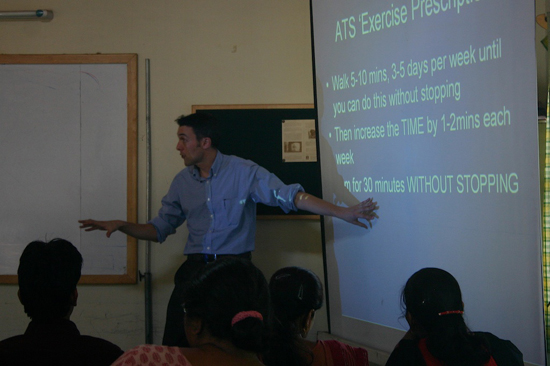 Dr John Hurst returned from volunteering at Sambhavna in November 2010; we caught up with him about his experiences there
Dr John Hurst returned from volunteering at Sambhavna in November 2010; we caught up with him about his experiences there
1. Can you tell us a little about your job?
I am a specialist in Respiratory Medicine, with my time divided 50/50 between NHS duties as a Consultant at Royal Free Hampstead NHS Trust, London, and my role as a Senior Lecturer in Respiratory Medicine at University College London (UCL) Medical School. At UCL I am involved with medical research and teaching medical students. My particular interests are in lung diseases called chronic obstructive pulmonary disease (COPD) and bronchiectasis.
2. How did you come to volunteer at Sambhavna?
Quite by accident. I travel to India a lot as my partner, an eye surgeon, was born in Delhi and there is a link between our hospital in London and an eye hospital in Bhopal. Last year we were travelling to Bhopal and visited a shop in Delhi to buy Dominique LaPierre’s book – I wanted to read it on the train. Much to my surprise, the assistant in the shop asked if I wanted to meet the author – “as he’s over there”. We introduced ourselves, explained we were doctors from the UK, and Dominique and his wife suggested I visited Sambhavna whilst in Bhopal. Sathyu showed me around the clinic, and I left impressed with the comprehensive, patient-centred approach that was being taken. I also came away with the strong desire to go back and volunteer and, a year later, I am just back from four days working with the team at Sambhavna.
3. Do you remember the Bhopal disaster?
Oh yes, though I was just 11 at the time, and as this was before I ever started to watch the news regularly I guess it was the severity of the disaster that must have struck me.
4. So what did you do at Sambhavna?
The clinic had arranged for around 30 patients with respiratory problems to attend on each of the four days I was there, so I saw perhaps 120 patients in total. I was in clinic with two of the Sambhavna doctors, and other clinic staff. We assessed the patients’ diagnoses and developed management plans together. Two aspects were particularly important: I aimed to reinforce the experience the clinic staff already had using equipment called a spirometer, which is important in diagnosing (or excluding) lung diseases. And whilst the inhalers available to patients at Sambhavna are similar to those I have available here in the UK, I was able to encourage all the staff to check the patients were actually using their inhalers properly, so that the treatment was getting into the lungs where it is needed most.
I also did some educational sessions about a treatment called ‘Pulmonary Rehabilitation’ which is an exercise and education programme for people living with lung diseases. This approach can be as effective as the best inhalers, and fits well with the ethos of the clinic in combining the best allopathic (‘Western’) and ayurvedic (‘complementary’) techniques. Many of the community workers attended this training and my hope is that they can now pass on this knowledge to people living in the surrounding area.
5. Did you get anything out of the visit?
Absolutely – for a start, I will not be complaining about how busy my NHS clinic is for a while! Academically, I was also very interested in how the gas has affected the survivors. There was some research published a while ago that demonstrated a greater effect on the lung in patients who had been living closest to the factory on the night of the disaster. In addition, the survivors’ lung problems look a little like COPD on the tests, which is interesting to me as it suggests that a single large exposure can result in similar problems to longer term but less intense exposures, such as cigarette smoking.
6. Will you go back?
I’d love to go back, either to do some more clinical medicine or perhaps research and I am investigating the possibilities for that at the moment. I would also like to return with specialists from different areas, and for example the clinic are particularly interested in endocrinologists as there are high rates of diabetes and thyroid problems in the local communities.
Photographs by Dr John Hurst, and Mr Jonathan King (final year medical student, UCL)
PHOTO 2: Dr Hurst demonstrates how to use a peak-flow meter which is helpful in patients with asthma.
PHOTO 3: The clinic staff use an electronic spirometer to help diagnose lung problems.
PHOTO 4: Demonstrating to a patient how to use their inhaler correctly.
Would you like to volunteer at Sambhavna?


